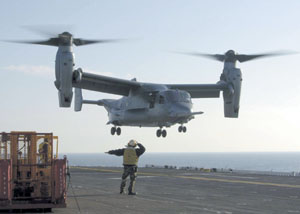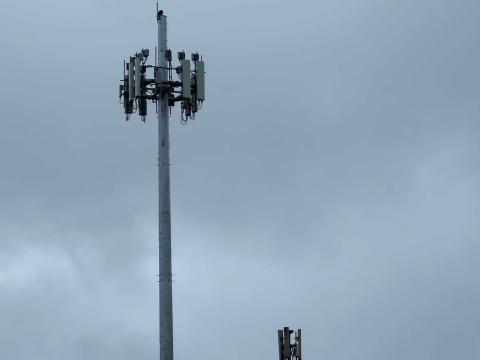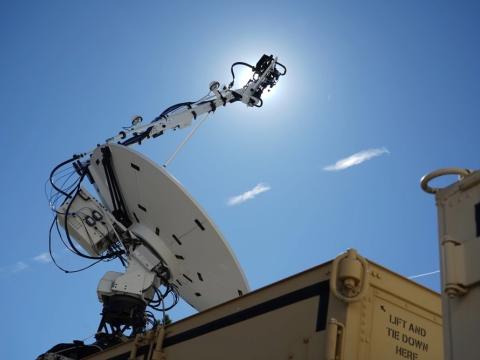Defense Supply System To Out-Maneuver a Flexible Enemy
 |
|
The sense and respond logistics concept (SRLC) seeks to develop a more flexible approach to supplying troops in battle. The effort uses a variety of methods–-from software management tools to a flexible philosophy embracing training and nontraditional thinking–-to change organization culture. Designers are examining new systems such as this V-22 Osprey tilt-rotor aircraft to replace or augment helicopter-based logistics support. |
Network-centric warfighting systems are outpacing the U.S. military’s logistics systems. This realization, which unnerved millions of Americans as they watched operation Iraqi Freedom unfold on television, has lead to the development of a prototype adaptive response capability for U.S. military logistics operations. The technology consists of a software-agent-based system for tracking and locating supplies to support warfighters. Instead of coordinating the massing of supplies in staging areas and moving them forward, it dynamically tracks units and predicts their needs and allocates the nearest available resources.
Although network-centric warfare has existed for several years as a concept, it is still in its infancy in application and practice. Connecting sensors to weapons and intelligent management systems dispersed throughout a force’s platforms can provide commanders with multiple levels of situational awareness beyond the location of enemy and friendly units. The near future may see the emergence of a fully networked environment where data on a unit’s every need is fed into a dynamic system that locates fuel and other supplies and provides them through advanced airlift and transport capabilities without forming traditional supply lines.
The goal of the sense and respond logistics concept (SRLC) is to study the effects of network-centric technologies on logistics and to create a new operational architecture and philosophy based on that data. Funded by the Office of Force Transformation (OFT), Arlington, Virginia, the effort seeks to develop ways to improve radically the ability of forces to perform on the battlefield, explains Capt. Linda M. Lewandowski, USN, chief transformation strategist with the Office of the Secretary of Defense, Force Transformation.
The program developed a formal model for sense and respond logistics (SRL) to create a joint adaptive logistics capability. Developers also are examining the behaviors, mathematics and science underlying networks to translate them into operational concepts and procedures. Research has determined that tactical SRLC applications must be flexible, featuring self-synchronization and the ability to network to achieve a larger outcome. These local efforts then tie into larger actions on the battlefield.
According to Capt. Lewandowski, studies of SRLC capabilities during operation Iraqi Freedom detected a growing gap between networked combat systems and current logistics applications. Battlefield operations moved so quickly that they outpaced their supply lines. The goal is not only to develop a faster command and control loop, but also to create the ability to out-adapt a flexible enemy. However, to be effective, the system must reach down to the tactical level. This capability does not exist today, she says.
The effort seeks to move away from top-down, centralized decision-making hierarchies to a more decentralized model. The system may have a profound impact on command and control because it promotes more decision making at the tactical level, in the distributed elements of a force. “You’re going to command by establishing and communicating the context. That’s really your control. You are dictating orders less and establishing the commander’s intent and making sure everybody is operating within the same context,” the captain offers.
SRL is a substantiation of network-centric warfare, she adds. The effort takes information age theory and principles and applies them to a large U.S. Defense Department environment. “What hasn’t been done yet is we haven’t taken [network-centric warfare] theory and principles and translated them into a more military and conceptualized context,” she says. The captain notes that, when the program began, its developers realized that SRLC was really a larger translation of network-centric warfare.
But network-centric warfare is only a step toward the concept of full joint warfare, explains Donald L. Zimmerman, chief executive officer of Synergy Incorporated, a Washington, D.C.-based technology firm developing the SRLC software component. Within the Defense Department there is a competition between different warfighting concepts that has not yet fully played out. “Some of those concepts are [aimed at] trying to get the network-centric flow down, and some aren’t yet. There’s a lot of work still to be done,” he says.
Capt. Lewandowski adds that, in her opinion, many recent concepts did not work in a network-centric context because they still retained aspects of traditional linear command structures. “It’s not going to mesh, because in network-centric warfare the difference is that you’re taking traditional functional areas of warfare and looking at the interrelationships and interdependencies,” she says.
In SRL, commanders will rely on data pulled in by the network to apply force to enemy weak points. This leverage will have to be created from available information about the enemy. “You want to try to change his [the enemy’s] behavior. And what you’re applying here are capabilities, like capacity packages—those are basically your forces: the bombs, bullets, platforms and everything else involved. That’s actually the execution, trying to apply the leverage to create those effects,” she says.
Because the sense and response concept is related closely to network-centric warfare, those involved in this effort are trying to describe a philosophy for operating in an information environment. This environment will be vital, or the military will not be able to pull together a fully networked system successfully, she says. Once integration is achieved, it removes institutional and service boundaries and creates the necessary speed for applying forces on the battlefield with the right equipment for the mission.
Speed is a key factor. Capt. Lewandowski notes that a major lesson from operation Iraqi Freedom was that speed, agility and precision are hallmarks of modern U.S. warfighting. In this distributed environment, the logistics structure must be designed to construct force packages of soldiers and equipment quickly. “It doesn’t matter where they are at. Some will be in theater, others back in the United States—they’re going to be all over the place. I need to rapidly assess the problem, decide what I want to do, bring the packages together and employ them,” she says.
This is an important change because, while combat systems are adapting to a nonlinear battlefield, logistics and support elements are still organized in a linear fashion. This creates a pause in action between rapidly advancing mobile forces and their support. For example, during the Iraq War, U.S. forces had to stop their advance on Baghdad because they were too far ahead of their supply chain. If this gap is not closed, reliable, timely support may not be available for future mobile units, the captain warns.
To avoid this pause, an SRLC system must be flexible and adaptable. The network will allow commanders to do more than just locate materiel. It will also permit them to build force packages of varying sizes to meet their operational needs, Capt. Lewandowski says.
An implication of SRLC is that the role of the logistician will diminish and evolve into that of a software operator. Although this change will not happen immediately, many logistics functions will be built into information systems. SRLC also will have a profound impact on command and control as automation will significantly reduce the number of personnel necessary for headquarters and logistics staffs.
Because the concept ties into network-centric warfare, SRLC requires large amounts of incoming data to sense and affect leverage points. Human operators will not be able to handle the volume of information by themselves. The planners of this effort are developing software-based agent technology to sift for relevant data. Capt. Lewandowski notes that, during the rush to Baghdad, the old paper-based logistics system was not able to keep up with the rapidly moving coalition forces. To work, the concept must be invisible to the user. All the technology has to do is provide leaders with unit readiness and status, she says.
The SRLC effort began in 2002 at the tactical level and scaled itself up as it acquired more information about how systems worked in a networked logistics chain. The captain stresses that it is not a traditional program, explaining that the flexibility required for the discovery and invention process does not fit within the concept of a traditional program office.
Capt. Lewandowski notes that capabilities-based systems require rapid experimentation and prototyping from their point of effect—the battlefield—back to the supply source. This type of capability does not exist in today’s logistics systems. Rapid prototyping and development of operational ideas create a high learning curve within an organization, which affects its entire culture. This is very different from the traditional spiral development philosophy of the Defense Department. But the goal of rapid prototyping/learning is to change an organization’s culture as well as its operational capabilities. To achieve full potential, a capabilities-based system cannot be engineered, it must evolve through the discovery and experimentation process, she says.
Although it is a technology development program, it is not necessarily about building an information technology system, explains Zimmerman. To meet the program’s needs, Synergy developed an enterprisewide application to link systems. After the Office of Force Transformation awarded a $2 million contract in June 2003, the firm had its first software shells and agents running and communicating with each other by September. It is a highly scalable system capable of large, collaborative data-sharing transactions across a network.
Zimmerman notes that the application was inspired by software used for stock trading and financial markets. The tool has to manage large volumes of rapid transactions without overwhelming a human operator. Synergy’s programmers also built in an intelligent software agent capability to manage mutable decision rules. Several types of interactions are defined, for example, agent to agent and agent to human. In agent to human, the system proposes options, and a commander’s intent is then built into the operational rules. One of those rules makes humans responsible for all important decisions. The proportion of agent-to-agent and human-to-machine interface can be changed within the system.
The prototype uses commercial software and database systems such as Oracle. The system also can use any vendor technologies available on the market. It operates in a Microsoft Windows environment, but it is also Unix oriented. Zimmerman believes a low-cost approach will have a better chance of implementation than would an expensive, high-end system.
The tool uses the Defense Advanced Research Projects Agency’s intelligent agent technology in its framework. Zimmerman describes an agent as a piece of code that can autonomously operate a set of rules. Software agents’ advantage is that they can quickly be given new rules, he says. For example, an agent can be used to represent a truck’s attributes in the system, such as parts and fuel.
The prototype includes several different types of agents. The demand agent is designed to listen to user demands. It applies logic to validate and invalidate user requests and passes them on to supply and demand agents. He notes that it is theoretically possible to have agents represent every person, vehicle and piece of equipment in a force package to create a dynamic model for mission planning and simulation.
Zimmerman notes that technology is not a hurdle to implementing the SRLC. The primary challenges are developing rules and overlaying them to military use. The system goes beyond technology to affect the training and culture of an organization and how people work, he says. But the system must create a network-centric ethos within the Defense Department. He notes that European nations, notably the United Kingdom, Sweden and Denmark, also are experimenting with SRLC systems for their militaries.




Comments